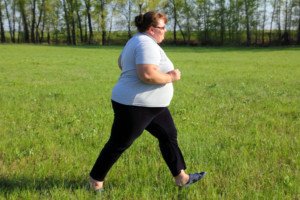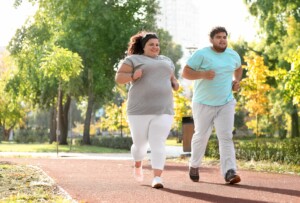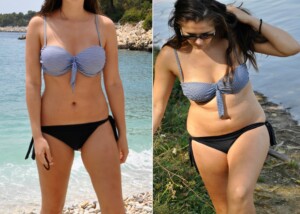
High intensity interval training (HIIT) isn’t reserved for just thinner people; obese or very overweight women and men are much capable of employing this method of exercise.
There is probably nobody who stands to benefit from HIIT more than the obese, although they are often the last ones to join in on this type of workout.
Why are obese people reluctant to try HIIT after they learn about it?
For some, their reluctance comes not from a dislike of anything that promotes good health and fitness, but from concerns that their body simply will not be able to take the stress.
They don’t want to pass out or have a heart attack, which is a major concern for people who are seriously out of shape.
Yet, slimming down and increasing cardiovascular health through HIIT helps overweight people avoid these disastrous events.
Yes, Seriously Obese People Really Can Do HIIT

Shutterstock/Kokhanchikov
It is very important to get clearance from a doctor before doing HIIT if you are obese.
This is to make sure that your heart and lungs are healthy enough to take what will prove to be one of the most life-transforming activities you ever experienced.
Unless they already have a serious condition, most overweight people will get doctor approval.
In fact, many might be surprised at just what they can do.
Self-discovery is one of the benefits of doing such a demanding workout and may prove even more enjoyable than seeing the pounds melt away.
Obese HIIT Participants Must Know When to Stop
There are two types of pain or signs that might arise when doing this type of workout, and one type is concerning, while the other is healthfully addictive.

Shutterstock/New Africa
Even if you are obese, getting out of breath during a HIIT workout is not a problem.
Your respiratory endurance will build as you continue working towards your goal.
It is okay to stop and catch your breath at the beginning, but know that heavy breathing is an important part of the workout.
Know when to push yourself and reach beyond your usual limits. Try every move until you master them.
It takes only a very short few days for those who are overweight to feel and see the positive difference that high intensity interval training makes in their lives.
- Stop the exercise if you feel nauseous.
- Immediately cease if you have chest pain or tightness.
- End the session if your hip or knee joint starts hurting.
If you’re obese and really want to get in shape relatively quickly, then push yourself without hurting yourself, and get started with these HIIT guidelines Part II for the overweight, and a more in-depth article on how HIIT strips off fat.
 Lorra Garrick is a former personal trainer certified through the American Council on Exercise. At Bally Total Fitness she trained women and men of all ages for fat loss, muscle building, fitness and improved health.
Lorra Garrick is a former personal trainer certified through the American Council on Exercise. At Bally Total Fitness she trained women and men of all ages for fat loss, muscle building, fitness and improved health.
.









































